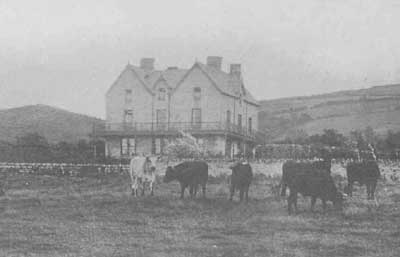Hywel
Tudur ~ 1840 - 1922

Hywel Tudur (second from the left, front row)
Poet, preacher and inventor. Originally from Pandy Tudur. His father was a builder.
He received teacher-training at the Caernarfon Training
college and came as a teacher to Clynnog because he
wanted to be close to his idol, Eben Fardd. His name
appears in the Clynnog School records in 1863 (the
year of Eben Fardd's death). He married a daughter
of Hafod-y-wern, Clynnog. He subsequently became headmaster
at Llanllyfni School. He left in 1874 because the inspector
was not satisfied with the school's results. (An Englishman
was appointed in his place but the villagers turned
against him.) He went to farm at Hafod y Wern and started
to preach on Sundays. By 1879 he became responsible
for the chapel at Capel Uchaf.
In 1873, he and William
Jones, Bryngwydion edited the book 'Casgliad o Weithiau
Barddonol Eben Fardd'. (The Collected Works of Eben
Fardd.)
He was the winner in the
pryddest (a long poem in free metre) competition at
the National Eisteddfod at Conwy in 1897. He wrote
many examples of the englyn (a four-line alliterative
stanza), particularly ones in remembrance of the district's
departed.
He devoted himself to
two things: designing a flying-machine, and making
a machine based on the principle of "self-motion" - as he described "perpetual motion". He invented various machines with the help of carpenters and blacksmiths. But
his chief interest was the principle of flight. He
worked for a quarter of a century grappling with the
problem. He spent months on end closely watching the
movements of birds, beetles and bees through a magnifying
glass. The problem which faced him was - why are their
bodies so heavy and their wings so tiny?
He had the idea to invent
a propellor and applied himself to putting the plan
on paper for sending to the Patents Office in London.
An answer came, telling him that they had accepted
his preliminary designs for 'A Propellor or Driving
Wheel to put in motion vehicles, boats and flying machines'
on 14 October 1916.
He had the intention of
designing a glider, but due to lack of financial backing,
this was never fulfilled. (see pp 12-13 Hywel Tudur
1840-1922. Edited by Catrin Parri Huws, 1993).

Bryn Eisteddfod (about 1918-1920).
He was an architect. He
himself designed Bryn Eisteddfod and his family moved
from Hafod y Wern to live there. It was he also who
designed the third chapel at Capel Uchaf (this was
demolished in 2002). It is said that he based the design
of Capel Uchaf on that of Gwytherin - the central seats
on the same level as the ones around them (like an
island). From around the aisles, the side and back
seats sloped. A plan such as this meant that it was
easy to preach in this chapel because the members sat
together in the middle.
When Hywel Tudur died
in June 1922, the following paragraph about him by
Rev. John Owen appeared in the Calvanistict Methodists'
Year-book.
"Rarely would
one find someone with more reliable advice in every
circumstance. If one wanted to make a will - Hywel
Tudur. If there were need of legal advice without going
to town and paying a lawyer - Hywel Tudur. If help
were needed to design a house or to survey land - Hywel
Tudur. If a verse were needed for a memorial card or
gravestone - Hywel Tudur. If an article were needed
for Y Drysorfa (a Calvanistic Methodist magazine)
to immortalise a deacon - Hywel Tudur. If a pryddest
or an awdl (ode) were needed adjudication - Hywel Tudur.
And should no-one to require anything, Hywel would
take the time to perfect his flying machine, to shape
a poem, or write a sermon."
He was buried in Clynnog
Cemetery. A competition to write a memorial englyn
was set for the National Eisteddfod in Pwllheli in
1925; the winner was D. Jones of Penrhyndeudraeth.
But there is no stone to mark his resting place.
Many thanks to Sally Davies,
great-granddaughter of Hywel Tudur, for the photographs. |